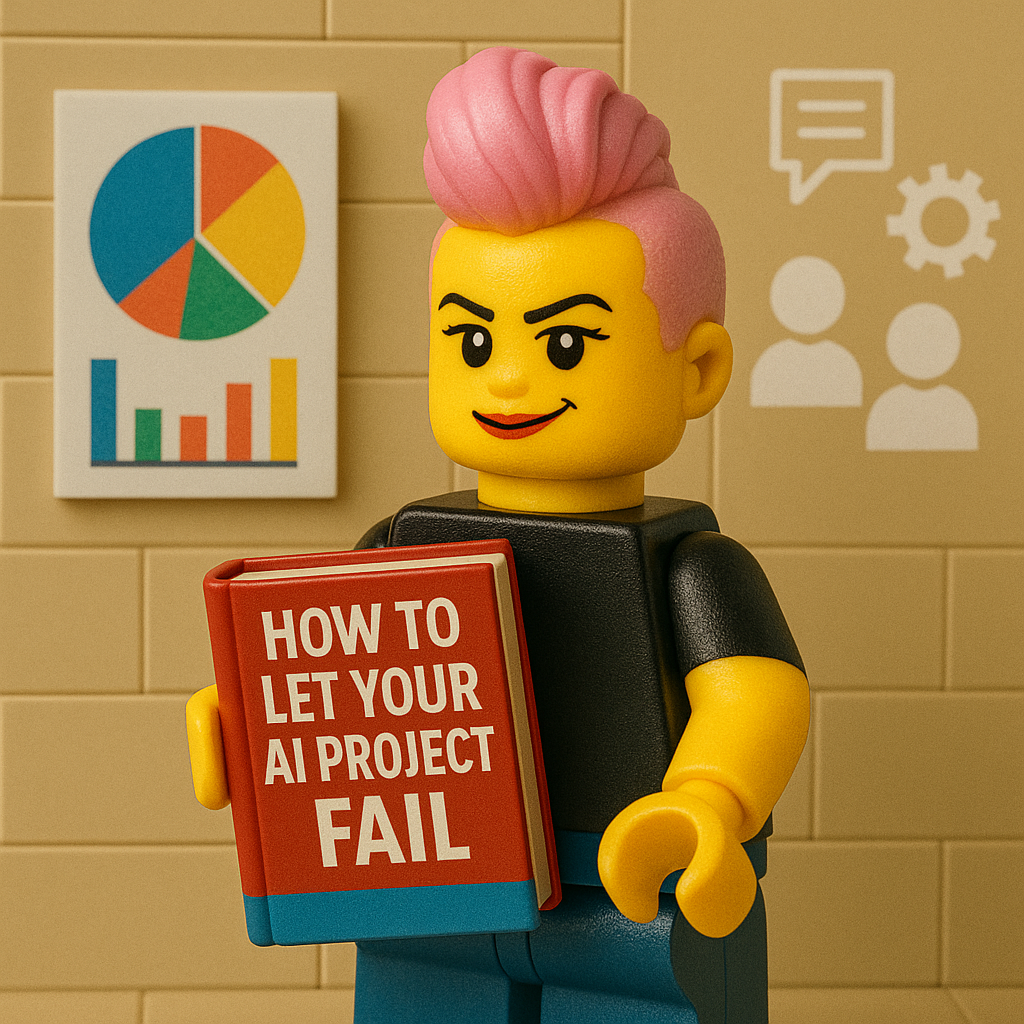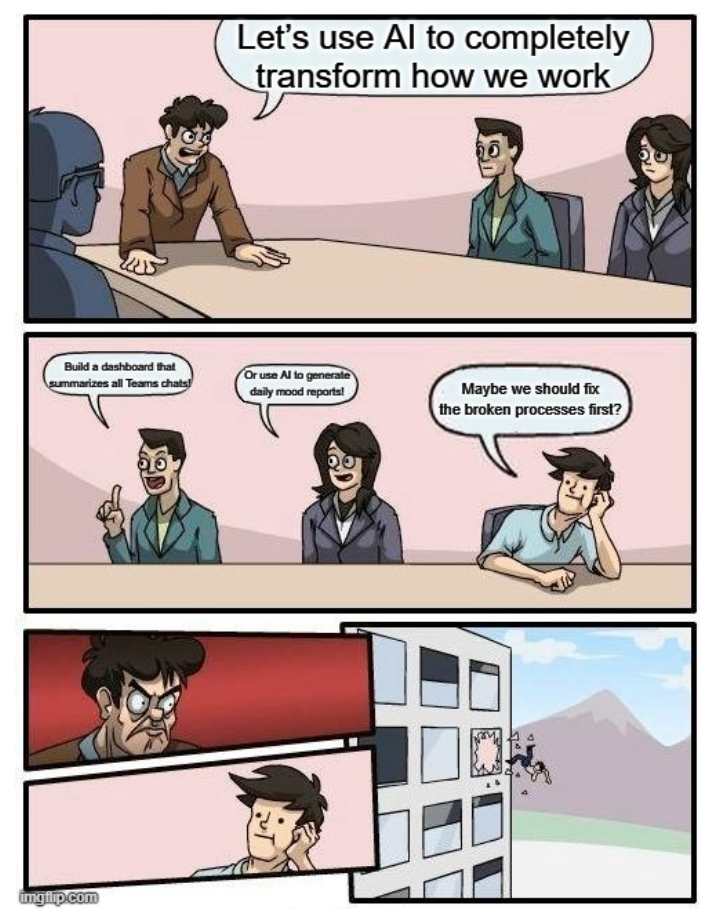How to let your AI project fail in spectacular fashion!

There’s never been more urgency to do something with AI. Boardrooms are buzzing; slide decks are glowing; consultants are circling. And somewhere in between the executive mandate and the whiteboard workshop, someone says it:
Let’s just start with a few use cases.
What follows is rarely malicious. It’s process. It’s governance. It’s a carefully choreographed dance of inertia, ambition, and misplaced optimism. And it almost always leads to the same result: nothing that truly matters changes. So if you’re aiming to fail your AI project with grace and budget intact, here’s a carefully curated guide.
1. Begin with a boundless, context-free Excel file
Forget Miro. Or talking with people. Real AI projects start in Excel, always have, always will. Someone heard at a conference that you need to start with a list of use cases, so you do exactly that. You send out a template to every department asking them to fill in:
- the use case title
- a short description
- expected value (TBD)
- business owner (also TBD)
- priority (which is always “High”)
By the end of the week, you have 137 rows. No duplicates, just thirteen slightly different versions of summarize meeting notes and seven interpretations of intelligent assistant for everything. Congratulations. You’ve achieved alignment through tabulation.
2. Democratize the discussion until it becomes unsolvable
Next up is stakeholder alignment. But make it a buffet. Invite everyone: product, HR, legal, compliance, data, ops. Now spend six meetings carefully defining terms like value and impact. Each department will have its own interpretation. The result? Two opposing paths:
- A minimal, low-risk use case—safe, invisible, and guaranteed not to offend
- A grand vision: AI-powered transformation, that spans every business unit and requires 18 months, 3 new vendors, and a dedicated tiger team. Choose whichever one ensures you won’t have to demonstrate impact before your next planning cycle.
3. Embrace the myths that quietly sabotage you
AI is new territory, but bad assumptions are timeless. These are the organizational beliefs that sound reasonable, until they quietly derail the entire effort:
- You can’t give everyone Copilot licenses ’like Halloween candy’ - Because clearly, we should wait until we know who’s productive before enabling productivity tools. Genius.
- We should only give licenses to power users - As if AI won’t reshape how non-power users work, collaborate, or decide. The logic: let’s transform work by empowering exactly the people who don’t want to change it.
- Use cases must show immediate ROI - A classic. We’ll only invest in experiments that have guaranteed returns, thus eliminating the concept of experimentation entirely
- Let’s focus on things that are easy to measure - Like token counts, number of summaries generated, or chatbot response times. Not actual impact on decisions, outcomes, or time saved
- Let’s test this in a department where nothing mission-critical happens. Perfect. If it fails, it doesn’t matter; and if it succeeds, it’s still irrelevant. A no-risk, no-reward strategy.
- We don’t need to involve IT until phase two. IT loves when people roll out security-sensitive pilots behind their back. Trust me.
- AI can just learn from our content. Yes, of course! AI will parse our 15-year-old SharePoint graveyard and instantly understand our unique company culture and acronyms.
4. Misunderstand the value of an AI-driven workplace (on purpose)
For real. Most organizations aren’t failing at AI because they’re technologically incapable; they’re failing because they don’t know what success looks like. Or worse—, ey define success in such narrow, quantifiable terms that they miss the point entirely. When we talk about AI in the workplace, we usually rush to tangible benefits:
- reduce hours spent on repetitive tasks
- generate faster outputs (emails, proposals, analyses)
- summarize content so we don’t have to read it
- streamline approval flows or ticket triage
- automate report generation and document creation
These are fine. They’re easy to measure and easy to sell. But if that’s all you get from AI, you’ve just made a slightly faster version of your current system, without changing how work actually happens.
The real potential lies in the intangible benefits:
- cognitive relief: not having to remember which folder holds the policy document from 2021
- confidence in starting: a blank page is intimidating; AI gives you something to react to
- inclusivity: helping people with different working styles, language proficiency, or neurodiverse needs
- better decisions: when analysis becomes trivial, people spend more time thinking
- momentum: removing friction so good ideas don’t stall at the first approval gate
But these only emerge when you redesign the systems people work in. If you just drop AI into a dysfunctional process, you get slightly faster dysfunction. And most orgs are fine with that.

5. Replace strategy with prompt engineering
Now comes the execution phase. Naturally, you’ll skip over:
- existing process inefficiencies
- broken data foundations
- user interviews
- change management
Why? Because you found someone who knows how to ✨talk to the model✨. Your new prompt whisperer assures you that success isn’t about systems or behavior change; but about mastering phrasing. Invest heavily in personas, tone sliders, and clever ways to ask AI to act as a senior consultant with 20 years of experience in our industry. After all, if the demo works, surely production will be fine.
6. Automate dysfunction at scale
Every failing AI project eventually arrives here: automation without transformation.
- don’t fix the process; just add a chatbot
- don’t question the workflow; just wrap it in a summarizer
- don’t challenge poor decision-making structures; just hope AI will clarify them
This is where AI becomes expensive window dressing. You might reduce some clicks, add a dashboard, or auto-generate a summary. But the system underneath—the approvals, the duplication, the unclear ownership—remains untouched. You’ve accelerated the wrong thing.
7. Celebrate the illusion of progress
At this point, you’ve technically delivered something. There’s a pilot. It has a name. Maybe even a logo. You announce it with fanfare:
🚀We’re proud to launch our first AI-powered assistant!🚀
No one uses it. No one trusts it. But it exists. And more importantly, it ticks the box on your innovation roadmap. You didn’t change how decisions are made. You didn’t create new leverage. But you did produce a very impressive PowerPoint. Mission accomplished.
8. The lesson we will now politely ignore
AI projects don’t fail because the models are weak. They fail because the organization avoids the hard stuff:
- clearly defining a real problem
- confronting the inefficiencies of its own processes
- acknowledging cultural resistance to change
- committing to outcomes, not experiments
We want the benefits of transformation without doing the work of transformation. And AI, with its promise of instant acceleration, makes that temptation harder to resist than ever. We could approach this differently. With honesty. With focus. With uncomfortable but necessary conversations. But there’s a new model out this week. Let’s start again.
Published on:
Learn more